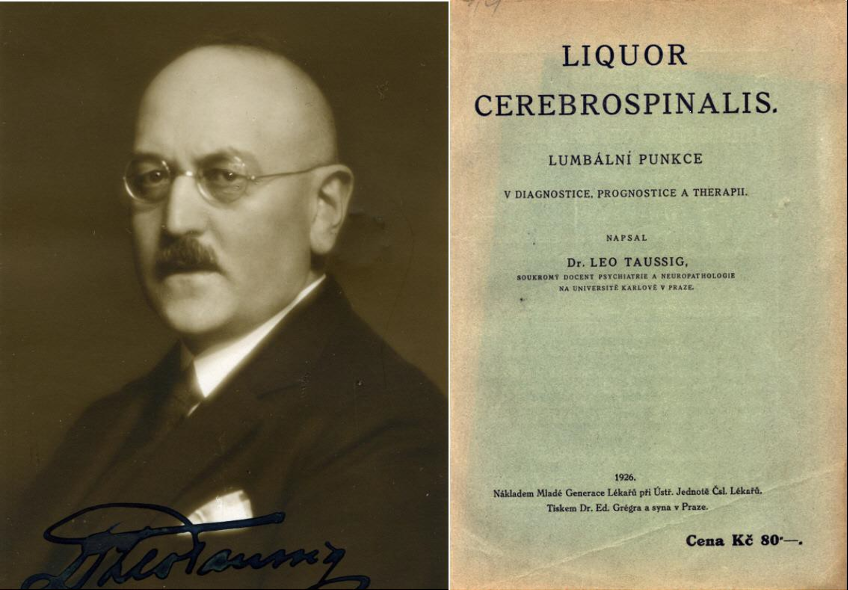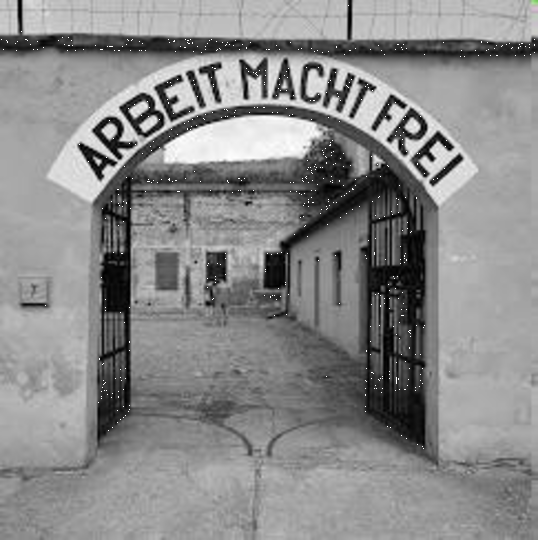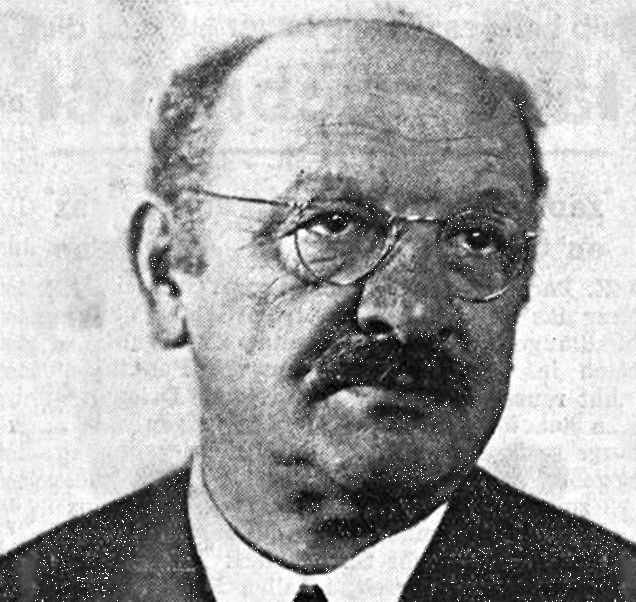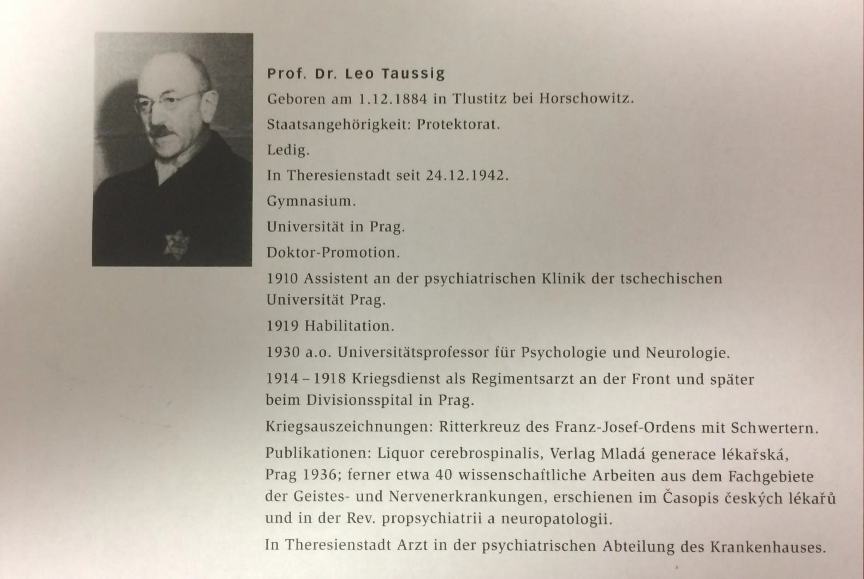While working on a new Eurocytology project chapter on CSF cytology, we felt a natural duty to pay at least a brief reference to the founders of today’s level of knowledge in the subject described. The preparation of a national course on cerebrospinal fluid cytology (1) brought us to the surprising finding of the little- known monograph by Professor Leo Taussig published in 1926 (2). The length of 440 pages and the content of this monograph accessible in the Medvik database (3) aroused interest in this work and its author (Fig. 1).
Who was Leo Taussig?
He was born on December 1, 1884 in Tlustice near Hořovice in a wealthy Jewish family.
All nine siblings lived to adulthood. His brother Adolf (1870 – 1913) was a professor at the Charles-Ferdinand University in Prague, a specialist in the treatment of tuberculosis.
Leo Taussig graduated from high school in Žitná street in Prague. After graduating from the Czech Medical Faculty of Charles-Ferdinand University in 1908, Taussig began his professional career briefly as an external ophthalmologist.
After completing his military service in 1909 – 1910 he joined the Psychiatric Clinic. In his youth he was a successful representative of the home village chess club (4) in domestic and international chess tournaments. Later, however, he concentrated on his profession. During the First World War he was a garrison doctor in Bohemia and Austria (in Graz). He was captured on the Russian front.

monograph on cerebrospinal fluid.
After the war he worked at the neurological department of the Divisional Hospital in Prague on Charles Square. He remained single.
Taussig lived in Plavecká Street with his sister’s family. There he maintained a private psychiatric and neurological practice after he was habilitated in April 1919 in the field of psychiatry. From 1931 on he worked as an external professor at Charles University.
He started dealing with cerebrospinal fluid soon after – since 1911.
The publication of the extensive monograph was preceded by more than ten partial reports on the origin, physiology, physical and chemical properties of cerebrospinal fluid, clinical aspects-indications and contraindications of lumbar puncture, the problem of induced mental disorders – folie à deux, mental disorders in basilar meningitis…
Leo Taussig was also a forensic expert in the field of neurology and psychiatry. He participated in the evaluation of insanity in the outline of the new Czechoslovak Criminal Code (1930).
The dark period of Taussig’s life began with his release from the Divisional Hospital in December 1934 – it is not entirely clear whether this was already a manifestation of the incipient persecution of the Jews. He was charged with assessing the working ability of Jews included in transports. During martial law after the assassination of Reich Protector Reinhard Heydrich prof. Taussig was arrested by the police on Wenceslas Square on June 6, 1942, where Jews were forbidden at that time. A certificate from the Jewish Community in Prague was required to be released.
In December 1942 he was transported to Terezin (Theresienstadt). He was on the list of “Prominenten” (5) along with a number of other prominent Jewish personalities of the scientific and artistic life.
The main and only temporary but uncertain “privilege” of the prominent people was protection from transport.
The Terezín (Theresienstadt) fortress founded in 1780 by Joseph II of Habsburg and named after his mother Maria Theresa became a ghetto in 1941. In fact, it was a transit camp – by 1945, 17515 – 12.5% survived from 139517 deported (Fig. 2).

Dr. Oscar Fischer, another outstanding jewish graduate and member of the academic staff of the Charles University in Prague – its German part, died in Theresienstadt 1942, when prof. Dr. Taussig was deported there. Fischer (Fig. 3) was the author of a priority publication on neurodegenerative changes (6) and in Taussig’s monograph was also cited as the author of the term “pleocytosis” of cerebrospinal fluid.
Professor Taussig worked in Terezín for two years in the psychiatric ward of the local hospital (Fig. 4). On 12 October 1944, Taussig was placed on a transport to Auschwitz, where he died on arrival.
In the third part of his memoirs (7), Professor Vladimír Vondráček writes about Professor Leo Taussig:
“One of the richest psychiatrists – he was co-owner of Komárov Ironworks. It was quite incomprehensible that he did not leave in time and stayed until the bitter end…”
“He was taller, always elegant, sociable, impeccable. He spoke calmly, slowly, clearly and in writing, correct and beautiful Czech. He only spoke when he had something to say. ”
After the war, his fate was remembered by his colleagues from chess clubs. From an article by K. Zmatlík in Šach (Chess) magazine in 1945 (8):
“Dr. Taussig belonged to the oldest of our generation of chess, which still operates … his exact methodical game, which was occasionally also elegant, was highly valued and feared by his peers. Later he devoted himself exclusively to the scientific career, he could no longer actively engage in chess, but he never stopped following his further development.
He was executed by the Germans not only as a Jew, but also as a representative of Czech medical science… ”

Portait of Dr. Oskar Fischer

Portrait and details of Prof.
Taussig from the file of the Terezín
(Theresienstadt) Ghetto.
Conclusion
Unlike Dr. Fischer’s published work in German, which has been found and awarded at least recently (9), Taussig’s monograph on cerebrospinal fluid printed in Czech remains internationally unknown despite its remarkably complex treatise.
There is no doubt that the cultivation of national culture and language must be accompanied by communicating quality results in a language understandable to the international scientific community.
The problem of racial intolerance is still with us to this day. Early and violent losses of scientific and pedagogical careers are forever a warning of the dangers that racism can pose to the profession to which we dedicate our own lives.
Jaroslava Dušková1, OndřejSobek2
- Inst. Pathol. 1st Faculty of Medicine, Charles University and Faculty General Hospital, (e-mail: jaroslava.duskova@lf1.cuni.cz)
- Laboratory for liquorology, neuroimmunology, pathology, and special diagnostics, Topelex ltd., Prague, Czech Rep.
Supported by Ministry of Health of theCzechRepublic – Project RVOVFN64165
References
- Dušková J, Sobek O. Cytologické vyšetření mozkomíšního moku. (Cytology investigation of cerebrospinal
fluid). Cesk Patol 2019; 55(3): 146-158.
- Taussig L. Liquor cerebrospinalis: Lumbální punkce v diagnostice, prognostice a terapii. (Liquor cerebrospinalis: Lumbar puncture in diagnostics, prognostics and therapy.) Praha: Mladá Generace Lékařů; 1926: 440.
- Medvik. Catalog of the National Library of Medicine. https://www.medvik.cz/bmc/searchcl.do?agid=507691&btype=128&acontext=6
- Zach T., Šandová M. Universitní profesor MUDr. Leo Taussig- lékař, šachista- významná osobnost Podbrdska. (University Professor MUDr. Leo Taussig – doctor, chess player – important personality of Podbrdy.) Proceedings of the Museum of Dr. Bohuslav Horák in Rokycany, 2010, č.22, 110-123
- Feuß A. Das Theresienstadt-Konvolut. Altonaer Museum in Hamburg, Dölling u. Galitz 2002, 112.
- Fischer O. Miliare Nekrosen mit drusigen Wucherungen der Neurofibrillen, eine regelmässige Veränderung
der Hirnrinde bei seniler Demenz. Monatsschr Psychiat Neurol 1907; 22: 361–72.
- Vondráček V. Konec vzpomínání: (1938-1945) (End of memoirs: 1938-1945).1st ed., Avicenum, 1988, 326.
- Zmatlík K.: Šest let německé okupace a její oběti.( Six years of German occupation and its victims.) Šach
(Chess) , 1945, nr.5-6, s. 50.
- Goedert M. Oskar Fischer and the study of dementia. Brain 2009; 132(Pt 4): 1102-1111.
Photos resource: Holocaust Victims Database [online resource]. Prague: Institute of Terezín Initiatives, c2007- 2016 [cit. 2023-02-18]. Available from WWW: www.holocaust.cz.

